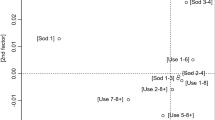Abstract
With n individuals ranking m objects, the exhaustive comparison approach, proposed in this paper, produces a list of order vectors sorted by the relative number of concordant pairs. The exhaustive comparison approach compares all possible order vectors instead of "an" optimal order vector to help the data analyst to consider "practical" solutions rather than a "desired" solution. An overall concordant order ratio is proposed to measure "how well" each order vector may represent the ranking structure of an ordinal data set. And the marginal concordant ratio evaluating the goodness of fit of each object in each order vector is also proposed in this paper. Comparisons among some popular ranking methods are discussed in this article. An empirical survey data regarding how travellers considered various factors for choosing travelling locations are used to illustrate the proposed method and calculations.
Similar content being viewed by others
References
Arrow J. K. (1963). Social Choice and Individual Values. 2nd ed. New Haven: Yale University Press.
Borda, L. C. (1781). “Mémoire sur les tlections au scrutin”, Mémoires de l'Académie Royale des Sciences.
Cook, W. D. and L. M. Seiford. (1982). “The Borda-Kendal Consensus Method for Priority Ranking Problem”, Management Science 6, 621–637.
Cook, W. D. and L. M. Seiford. (1978), “Priority Ranking and Consensus Formation”, Management Science 16, 1721–1732.
Diaconis, P. (1988). Group Representations in Probability and Statistics. Hayward: Institute of Mathematical Statistics.
Fechner, G. T. (1860). Elemente der Psychophysik. Leipzig: Breitkopf und Härtel.
Hildebrand, D. K., J. D. Laing and H. Rosenthal. (1977). Analysis of Ordinal Data. Sage, University Paper series on Quantitative Applications in the Social Science. 07-008. Beverly Hills and London: Sage Publications.
Johnson R. A. and D. W. Wichern. (1992). Applied Multivariate Statistical Analysis. 3rd ed. Englewood Cliffs: Prentice-Hall.
Kendall, M. G. (1962). Rank Correlation Methods. 3rd ed. New York: Hafner.
Kendall, M. G. and B. B. Smith. (1940). “On the Method of Paired Comparisons”, Biometrika 31, 324–345.
Kruskal, W. H. (1982). “Ordinal Measures of Association”. Journal of the American Statistical Association 53, 814–861.
Lansdowne Z. F. (1996). “Ordinal Ranking Methods for Multicriterion Decision Making”, Naval Research Logistics 43, 613–627.
Marden, J. I. (1995). Analyzing and Modeling Rank Data. New York: Chapman & Hall.
Riker, H. W. (1982). Liberalism Against Populism. San Francisco: W.H. Freeman and Company.
Rodrigues, O. (1839). Louiville Journal of Mathematics 4, 236.
Taiwan Tourism Bureau. (1996). Survey Report on R.O.C. Domestic Tourism for 1995 (Chinese).
Author information
Authors and Affiliations
Rights and permissions
About this article
Cite this article
Chang, W.C., Chu, PY., Ding, C.G. et al. Analyzing Ordinal Data for Group Representation. Group Decision and Negotiation 9, 47–61 (2000). https://doi.org/10.1023/A:1008744805975
Issue Date:
DOI: https://doi.org/10.1023/A:1008744805975




